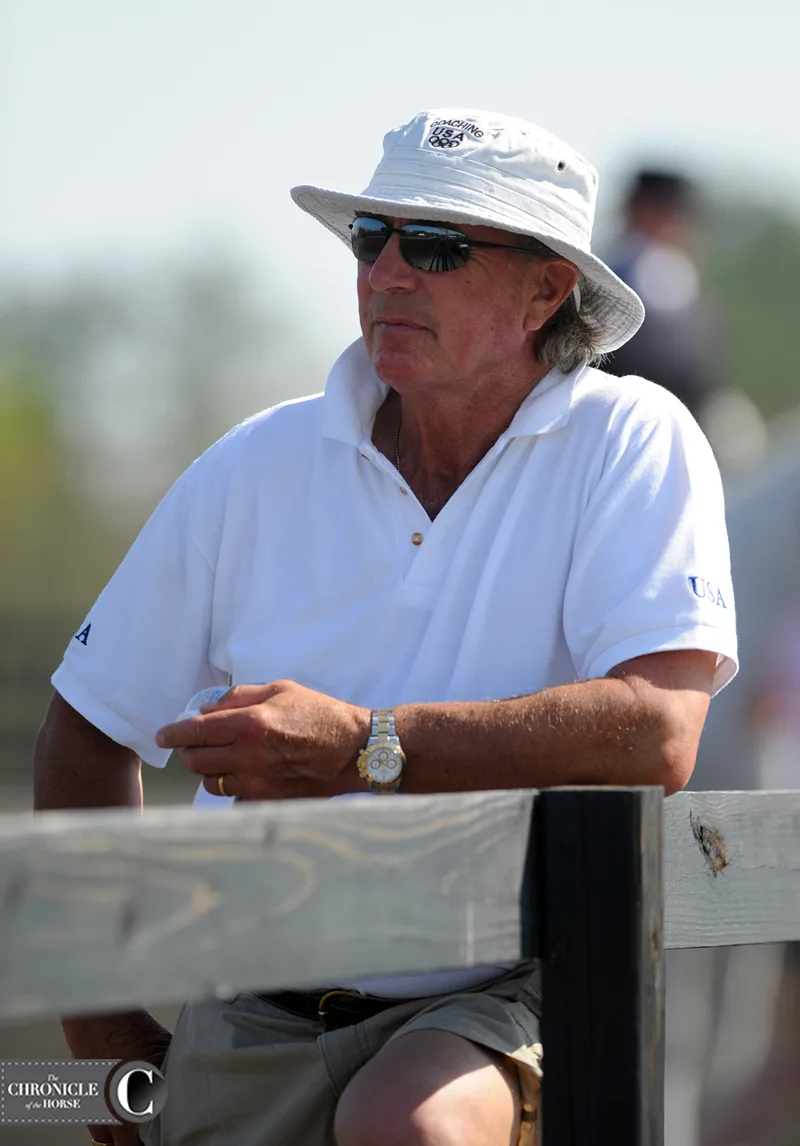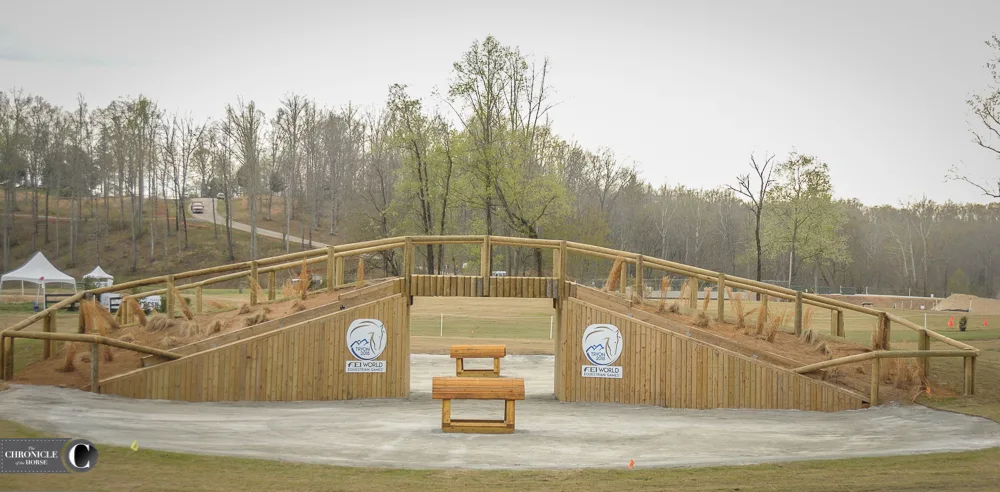Capt. Mark Phillips has designed many a testing cross-country track over his career, but the 2018 FEI World Equestrian Games at the Tryon International Equestrian Center in Mill Spring, North Carolina, will mark his first world championship course.
He sat down with the Chronicle to provide a preview of his plans for the eventing championship, which begins Sept. 13. The cross-country will occur on the former White Oak golf course property adjacent to the TIEC grounds and will share some of the same ground as the marathon course for the driving championship.

Mark Phillips will make his world championship design debut at the 2018 FEI World Equestrian Games. Photo by Sara Lieser.
“The start is where the training start is [for The Fork Horse Trials, which served as the test event], and the course will then run down and over the middle bridge,” said Phillips. “The third fence will be near the ‘mansion’ jump on the Fork course, immediately after the bridge and near the VIP tent. Then they will run around the lake back to where the cabins are on the hill above the water complex; that’s the Chimney Rock complex. Then they will come down through the water, along to the Sandy Plains Road, across the bridge, then all the way up the other side of the creek. After they get to the Longines water at the driving hazard bridge they will then go up three tiers on the mountain that is currently under excavation. The tiers constitute a climb of about 70 feet. I’m guessing the incline will cover approximately 600 meters in total. There will be a brush combination at the top of the hill where they will reach the same grade as the polo field and the stadium, so the last minute and a half will be all flat. The finish will be in the stadium, which will be located on what is currently the derby field.”

The Tryon International Equestrian Center has made significant changes to prepare for the World Equestrian Games. Photo by Lindsay Berreth.
Organizers have installed high-end footing around the entire course and continue to groom the new galloping lanes. On areas that are still under construction, they’ll apply a base to the ground and then lay sod over the base and water it religiously until the WEG.
“The footing will be the best footing of any major championship,” said Phillips. “They will be running on millions of dollars of sod. If the sod has 120 days of growing with a good subsurface, sunshine, water and fertilizer, the footing will be amazing.”
Phillips competed in the 1972 and 1988 Olympic Games in eventing and the 1970 and 1974 Eventing World Championships, and his daughter Zara Tindall, the 2006 world champion, is a top eventing competitor for Great Britain. He was the U.S. chef d’equipe for the eventing team from 1993 until 2013.
“I’ve had teams for 25-30 years, so this is the first chance I have had to actually be on the other side of the fence, so to speak, asking riders the questions rather than helping them to answer someone else’s,” said Phillips. “The last championship I did was the Europeans in Luhmühlen [Germany], so obviously the Americans were not competing there, and I also did a Pan American Games before I started my 20 years with the U.S. team.
ADVERTISEMENT
“When you’re designing a course you’ve got to let the ground talk to you,” Phillips continued. “The standard is the standard at the three-star. Because it is a World Games there will be more options than we would probably normally do at the three-star level, so that if there are some less experienced people in the field they have a chance to get round. Therefore there will also be more options, but the quick route will be a true three-star test.”
Because of the undulations in the terrain, Phillips said the fences will look more significant than they might otherwise. “If you place the fence just over the brow of a hill, allowing horses to take off from the top, it’s helping the horse, but the optic makes the fences look bigger,” he explained. “Then you can also use the down slope after the fence.
“For instance you look at the white table by the water, and it looks like a big fence, but it’s only 1.15 meters high,” he continued. “Because of where it is on the ground, when you put them just over the brow, the optic is ‘wow.’ But all the way around the course, I’m really keen that the horses should understand the questions so the horses have the best chance to jump the fence, but the riders will have to really ride.”
Phillips admitted it’s tough to design a course that challenges the top riders and is safe for the less experienced competitors. “You cannot challenge the best in the world,” he said. “You have to allow Michael Jung, Philip Dutton and company to make it look easy, because if they are having to work to get around, the other end of the spectrum will look super ugly. What you hope for is that riders don’t see the ‘red mist’ [become over ambitious], and they take the options that are equal to their ability, rather than thinking, ‘Well if I get lucky I might be able to jump this one.’ That is not the solution. You need to jump the ones you know you can jump, not the ones where you hope you can get lucky. I’m not reinventing the wheel here. I’ve had to have the same conversation in the past with my team riders: If you don’t know you can jump it, don’t try.”

Mark Phillips designed a course suited for both ends of the ability spectrum. Photo by Lindsay Berreth.
Eric Bull’s ETB Equine Construction of Scottsville, Virginia, is building the eventing and driving courses. “I’ve done the Pan Ams and the [American Eventing Championships], but this will be my first WEG,” he said. “Since I was probably 16 or 18 and wanted to build horse jumps, I’ve wanted to build a WEG or an Olympic Games. So while it’s probably going to be the most difficult summer of my career it’s also the most gratifying. It’s what I wanted to do, and I’ve been given a great opportunity and a great place to do it. It’s going to be awesome.”
Phillips has worked with Bull and his crew before and said the key is giving Bull some creative license. “While I have an understanding of construction, my job is to design, and his job is to construct,” Phillips said. “While I might say, ‘What do you think of this idea?’ he will then say, ‘I’d like to use this size of timber here and that size of timber there,’ and that’s perfect. The more the construction is his idea, the more inspired the final product. If I tell him to do something he thinks is crazy, you know that’s not going to work. It doesn’t create a good atmosphere.”

Construction underway behind the derby field, which will hold the main stadium. Photo by Lindsay Berreth.
Richard Nicoll is designing the driving course, and the two courses will overlap in many places, such as at the water complexes. Phillips met with Nicoll at Tryon last year and went through his plan for the cross-country track. “Working with Richard has been easy,” he said. “Richard is a good man, and the chemistry has worked really well. We’re two professionals who know what we’re doing. In life if you let your ego get in the way of what you’re doing, it’s not a good thing. Everything is a compromise with an event like this. You have to work with the people flow, the traffic flow, the TV—you can’t only think about where to put the jumps.”
ADVERTISEMENT
When it comes to making the time allowed, Phillips thought the eight-minute mark would be significant.
“We know if you go too fast too early the horses tend to hit the wall,” he said. “Where can they hit the wall? At Tryon it could be on the hill at eight or nine minutes. When we first started the short format not going too fast too early was the challenge, and what we have here is the most intense version of the short format with 42 efforts in 10 minutes, which is 135 meters per effort. Normally the three-star is 140 meters per effort. Why that becomes difficult is because any fences like the water jump have a ‘speed ticket.’ When you’re galloping 600 mpm, you can’t maintain that through the water. If you look at people going through the water they are doing about 400 mpm. You’ve got to catch up that lost time somewhere, so every five meters per effort less you have, you have five meters less to make up that time, and here you also have the hill at the end. There’s not a lot of terrain other than the hill, but the horses need to be fit—otherwise it will be a long way home.”

Much of the terrain is flat, but Mark Phillips said horses will still have to be fit to make time. Photo by Lindsay Berreth.
Phillips also will use the jumps to make time more of a factor.
“This is a big water complex, so you keep them at a slower speed for longer because of the length of the water,” he explained. “You can also do the same in the ‘combinations’ that aren’t technically combinations. If two related fences aren’t 600 mpm galloping fences, you can make that a slow 50 meters. The riders will have to ask themselves, ‘Am I going to jump these two fences with 15 strides, 13 strides or 10 strides?
“Obviously in 10 strides you’re not losing time, but in 15 you are losing time,” he continued. “Because when the horses are going 375 mpm in show jumping you know they take a 12-foot stride. When they’re galloping cross-country their feet go at the same speed and same rhythm, but the stride lengthens. Therefore the speed determines the length of stride.”
September can be hot in Tryon, and it can also bring heavy rainstorms. Phillips has contingency plans for both. “If it’s 95 degrees and 95 percent humidity I can cut a section out and shorten the course,” he said. “If I have three inches of rain we also might have to shorten the course. I wouldn’t want to reduce it to less than eight minutes, but I could come down to eight. If you have to come below eight minutes you probably shouldn’t be running the competition anyway.”

Mark Phillips has contingency plans in case the North Carolina weather doesn’t cooperate. Photo by Lindsay Berreth.
Finally, he emphasized that the course will not be twisty in order to slow horses down. “I don’t believe in slowing horses down at the expense of flow,” he said. “Like I said before I want the horses to be able to understand the questions. I’m much more interested in being fair on the horses than being fair on the riders.”
















